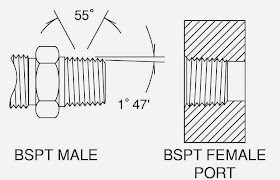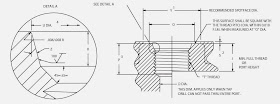- NPT
- BSPT
- BSPP
- Screw Thread
- S.A.E. Straight Thread
- Metric Thread
NPT Thread
NPT, National Pipe Thread or pipe taper is the most commonly used pipe thread in the United States and Canada.
Characteristics of NPT
- Thread Pitch measured in inches.
- Root & Crest Truncation are flat.
- 60° Thread Angle
- Taper Angle 1° 47’
BSPT - British Standard Taper
 |
| Figure 2 BSPT |
Characteristics of BSPT
- Taper Angle 1° 47’
- 55° thread angle
- Pitch can be measured in millimeters or inches
- Thread truncation is round
- BSPT threads are different from and will not substitute for N.P.T.
- threads.
The following standards are equivalent to B.S.P.T.
- ISO 7/1 (International Standards Organization)
- DIN 2999 (Deutsche Industrial Norme)
- JIS B0203 (Japanese Industrial Standard)
- d. BS 21 British Standard
 Form A
Form AA self centering taper is used at the hex which centers a “Bonded” washer (usually metal and elastomer) to seal to the surface surrounding the female thread.
Form B
A metal gasket (usually copper) performs the seal between the face of the body and the face of the female threaded component. For Form “B” replace “R” in P/N with “BR”.
A metal gasket (usually copper) performs the seal between the face of the body and the face of the female threaded component. For Form “B” replace “R” in P/N with “BR”.
Characteristics of BSPP
- 55° thread angle
- Thread pitch measured in inches
- Thread diameter measured in inches
- Root/Crest Truncation round
A parallel thread form uses the threads for holding power only and seals by means of an O-ring and retainer ring.
The following standards are equivalent to B.S.P.P.
- ISO 228/1 (International Standards Organization)
- DIN 3852 Part 2 & Parallel threads (Deutsche Industrial Norme)
- JIS B0202 (Japanese Industrial Standard)
- BS 2779 (British Standard)
Unified Screw Threads
These are very common threads utilized on valves and fitting stems, nut and fitting end threads. They are straight, NOT tapered threads used for holding power.
Screw threads are denoted by the following:
For instance: 5/16 - 20
Thread Diameter Number of Threads per inch
For instance: 5/16 - 20
Thread Diameter Number of Threads per inch
In general - screw threads can be further classified into various types of pitch’ (UNF) Unified Fine Pitch - (UNC) Unified Coarse - (UN) Unified Constant.
These classifications are determined by the relationship of threads per inch to outer diameter.
Note: For further information on thread pitch, please refer to ISO standards handbook or H-28 handbook.
SAE Straight Thread Port (SAE J1926)
Parker straight thread fittings shown are for connection with the SAE straight thread port as shown here. Basic port dimensions are give in Fig. 5 below. This port is the same as MS16142. It is also similar to, but dimensionally not the same as MS 33649 and AND 10050.
 |
| Figure 5 SAE Straight Thread O-ring Port Dimensions |
NOTE: Tap drill lengths “P” given here require bottoming taps. Increase “P” as required for standard taps.
NOTE: Diameter “U” shall be concentric with thread pitch diameter within .005 FIM. It should be free from longitudinal and spiral tool marks.
Metric Threads (ISO 6149-2)
The following sections were prepared with the intention of explaining that NONE of them should be confused with a metric thread.
Please remember that a metric thread, be it parallel or tapered is designated as metric by the distance in millimeters from thread crest to crest. In the case of the parallel thread Figure 6 the O.D. is also expressed in millimeters.
To assist you in determining the various types of threads, Parker has available the International Thread I.D. Kit/Bulletin 4303-B1. It includes calipers, international and screw thread pitch gauges.
If you would like to receive more information about Parker A-Lok, Parker CPI or Parker Pipe Fittings please contact the Forberg Scientific Mechanical Sales Team
Phone: 248-288-5330
Email: mechanicalsales@forberg.com






